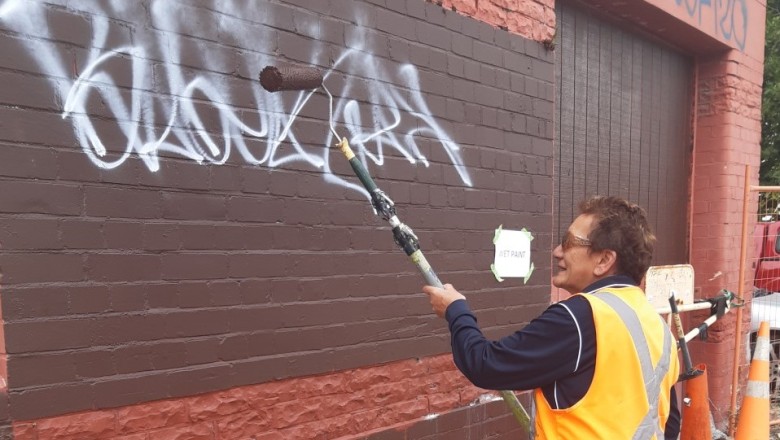Graffiti removal specialists
Keeping Christchurch clean of graffiti vandalism takes a lot of care and attention.
A specialist team of five dedicated full-time technicians work up to 250 hours a week removing graffiti vandalism around the city, Citycare Property Operations Manager Painting Steven Carey says.
This equates to approximately 84,000 square metres and 13,000 litres of various coloured paint in a year – the equivalent of around 10 rugby fields of painting.
“We work to keep our communities tidy and we aim to locate, paint over, and remove the graffiti before the public sees any offensive tagging,” Steven says.
The Christchurch City Council utilises Citycare Property to remove graffiti vandalism on the streets and most public spaces to a height of three metres, he says.
This includes footpaths, roads and lamp posts, on boundary fences at schools, parks, property frontages and walkways, on frontages of small business properties and on Council facilities and neighbouring properties.
The aim is to rapidly remove graffiti as this is best practice to prevent graffiti from reoccurring.
There are some graffiti hot spots, locations which taggers regularly and repeatedly target. Examples of common locations are skate bowls, pedestrian underpass tunnels, alleyways and walkways.
Citycare analyses the locations where graffiti vandalism is found and notes specific tags – they can be like signatures – recording the information for the council as evidence for the police.
Usually the busiest time for Citycare Property’s graffiti team is after the Christmas break and holiday weekends when taggers target normally bustling business areas which are quiet because people are away.
This year has been particularly challenging as taggers took advantage of the Covid-19 lockdown and the crew had to carry out massive clean-ups in the weeks afterwards, Steven says.
The team starts work early, before there’s too much traffic, to locate and remove the graffiti.
When large public events are scheduled, such as a Crusaders game or the City to Surf run, the team checks in advance to ensure the route and surrounding streets are clean of graffiti vandalism for spectators and participants.
The graffiti team works on a combination of responsive call-outs from the public and their own proactive rounds in areas of the city.
Their efforts are supported by a team of volunteers in the community, who help by reporting graffiti and assisting to remove some of it. Christchurch Mayor Lianne Dalziel recently thanked them publicly.
For the Citycare team, the most offensive tags are required to be removed within four hours.
Once those tags are painted over, the next priority is urgent painting on the major roads around Christchurch to remove tags where there are high volumes of traffic.
As an example of a typical month’s work, in September 434 tags were reported by the public, another 249 were identified by the team, and 15 pieces of the most offensive graffiti were urgently removed.
The alternative strategies are to paint over the graffiti with grey paint on surfaces such as fences and walls or for non-painted surfaces an eco-friendly, non-toxic, alternative graffiti remover specially developed in collaboration with Green Kiwi Clean Ltd is used. Water blasting the tagging is also used in some instances.
Once the graffiti is covered in the special grey paint, the team returns to paint the surface area as close to its original colour as possible.
For private properties, the team seeks permission and works with the owner to achieve a satisfactory result.
The team have a limited range of paint colours and will attempt to match as closely as possible within the range.
In the words of the Christchurch City Council:
The council funds graffiti removal because it considers that graffiti vandalism contributes to community unease. It can lead to a perception that an area is out of control and can increase the fear of crime.
The council’s objective is to significantly reduce the incidents of graffiti vandalism and improve perceptions of community safety. This in turn contributes to the reduction in the incidence of crime and the cost of graffiti vandalism removal to the ratepayers.

Citycare Property Graffiti Remover Rua Tate
